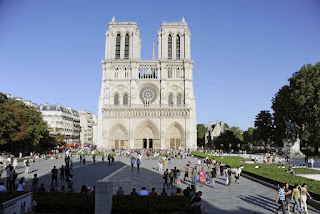View of Notre Dame cathedral's towers, in Paris, France. EPA/HORACIO VILLALOBOS.
By: Mike Collett-White
LONDON (REUTERS).- A British archivist believes he has uncovered the real-life inspiration for French novelist Victor Hugo's mysterious character Quasimodo, the deformed bell ringer of Notre Dame cathedral in Paris.
Adrian Glew, who works on the Tate collection's archives in London, was studying the seven-volume handwritten autobiography of 19th century British sculptor Henry Sibson when he came across a reference to a Frenchman whose nickname was "le bossu," or hunchback.
Sibson had been employed in the 1820s to carve stone as part of the renovation of Notre Dame in Paris which had suffered damage during the French Revolution in the 1790s.
But he fell out with one of his contractors and applied for another job at the government studios where he met a carver called Trajan.
According to Sibson, Trajan was a "most worthy, fatherly and amiable man as ever existed -- he was the carver under the government sculptor whose name I forget as I had no intercourse with him. All that I know is that he was humpbacked and he did not like to mix with carvers."
Glew immediately thought he was on to something.
"It was almost like peering into Tutankhamun's tomb and you see a glimpse of something that attracts your eye," he told Reuters.
Several Connections
He noted that Sibson was describing French artisans active in the same part of Paris where Hugo lived in the 1820s and, with his interest in the restoration of Notre Dame, the writer may have seen and even known Trajan and his hunchbacked boss.
"And also, Hugo proposed to his wife-to-be in Dreux, at a time when the team of sculptors and carvers were working there," he added.
Sibson was part of the team who went to Dreux, a town near Paris, which included both Trajan and M. Le Bossu, "a nickname given to him and I scarcely ever heard any other.
"M. Le Bossu was pleased to tell M. Trajan that he must be sure to take the little Englishman."
Further supporting his theory, Glew added, was the fact that the Almanach de Paris of 1833 listed all professional inhabitants in the area and included the carver Trajan.
That indicated he continued to work there during the period when Hugo wrote his famous novel (1828-1831). And in an early version of Hugo's "Les Miserables," the main character is Jean Trajean, a name Hugo later altered to Jean Valjean.
Glew has yet to discover Le Bossu's real name.
"It is tantalizing that we don't know what he was called," he said. "I'm still researching that."
Sibson's memoir will be on display outside the Hyman Kreitman Reading Room at the Tate Britain gallery from August 16 until the end of the month. Tate Archive celebrates its 40th anniversary this year.
(Bottom photo: Charles Laughton at 12)
Subscribe to:
Post Comments (Atom)



No comments:
Post a Comment